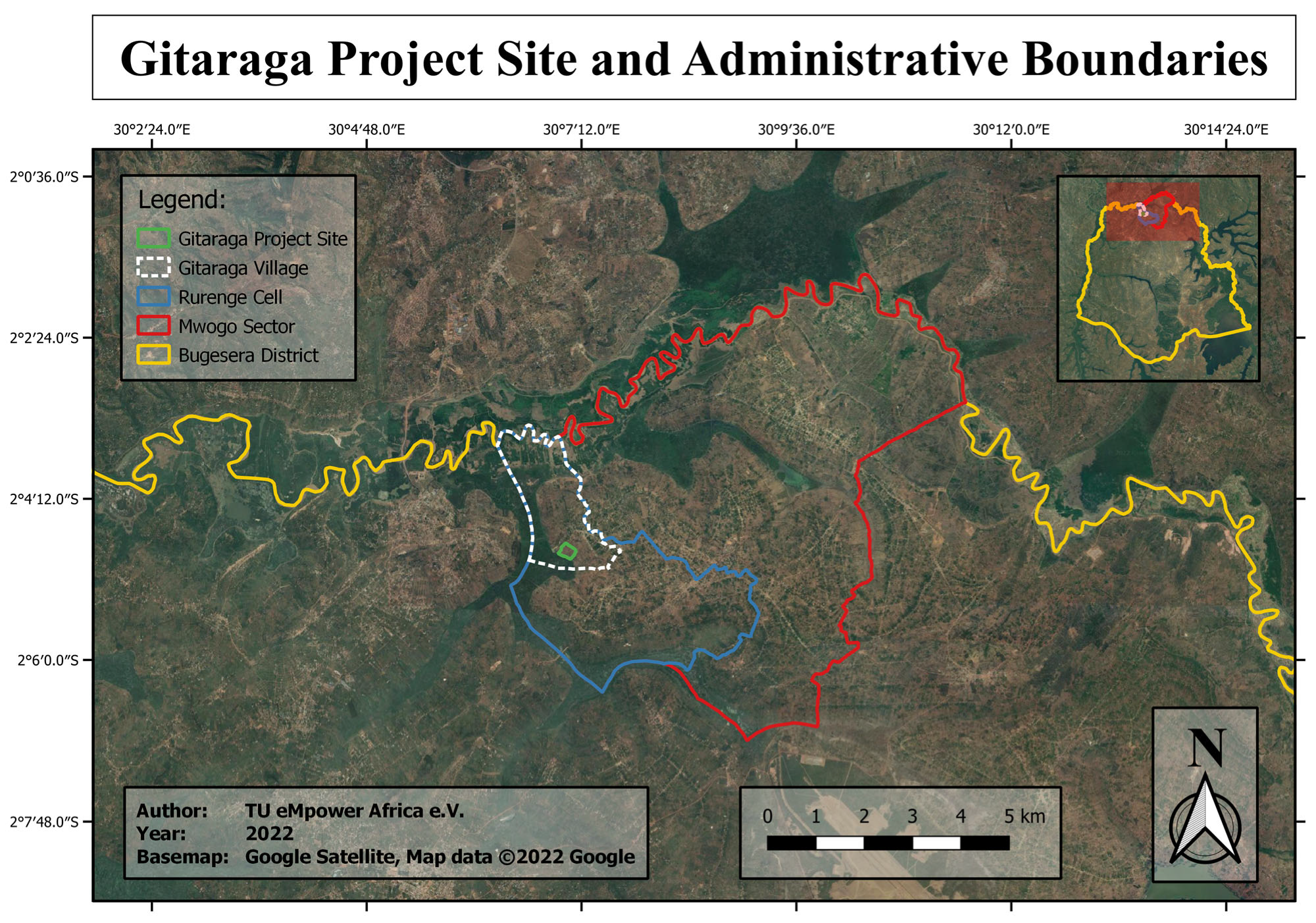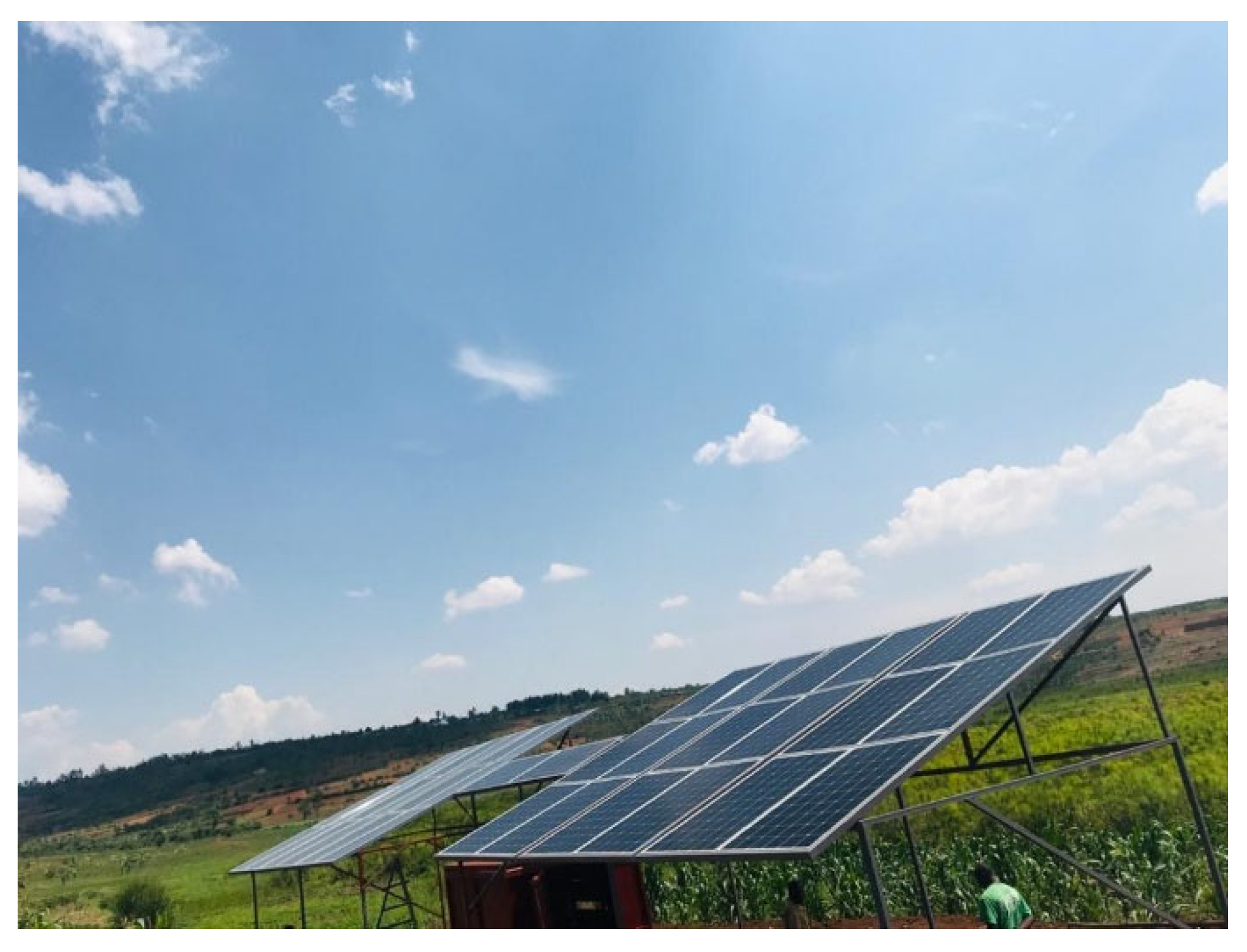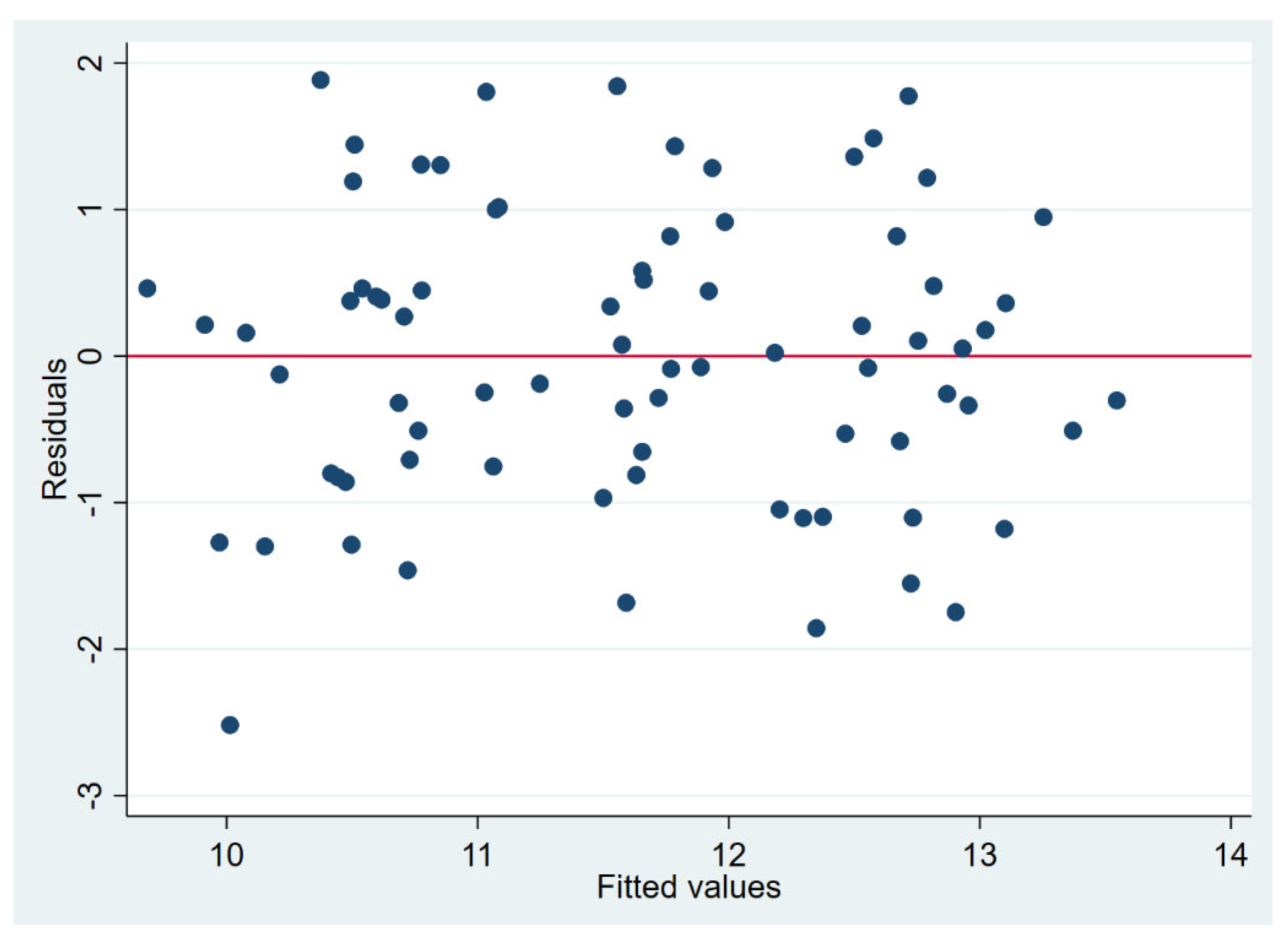Assessing the Technical Efficiency and Resilience of Rwandan Smallholder Farmers Participating in Small-Scale Irrigation Schemes
Abstract
1. Introduction
2. Materials and Methods
2.1. Study Area
2.2. Rwanda Small-Scale Irrigation Project
2.3. Sampling Technique and Sampling Size
2.4. Stochastic Frontier Analysis Model
2.5. Inefficiency Effects Model for Cross-Sectional Data
2.6. Statistical Description
2.7. Input Variables ()
2.8. Inefficiency Explanatory Variables ()
2.9. Output Variable ()
3. Results
3.1. Stochastic Frontier Estimation
3.2. Heteroscedasticity
3.3. Multicollinearity
3.4. Technical Efficiency
3.5. Determinants of Technical Inefficiency
4. Discussion
5. Conclusions
Author Contributions
Funding
Informed Consent Statement
Data Availability Statement
Acknowledgments
Conflicts of Interest
References
- Benjamin, E.O. Smallholder agricultural investment and productivity under contract farming and customary tenure system: A Malawian perspective. Land 2020, 9, 277. [Google Scholar] [CrossRef]
- Benjamin, E.O.; Ola, O.; Lang, H.; Buchenrieder, G. Public-private cooperation and agricultural development in Sub-Saharan Africa: A review of Nigerian growth enhancement scheme and e-voucher program. Food Secur. 2021, 13, 129–140. [Google Scholar] [CrossRef]
- Guo, Q.; Ola, O.; Benjamin, E.O. Determinants of the adoption of sustainable intensification in southern African farming systems: A meta-analysis. Sustainability 2020, 12, 3276. [Google Scholar] [CrossRef]
- Ngango, J.; Hong, S. Production Efficiency and Adoption of Intensive Agricultural Practices in Rwanda’s Maize Production; Chungnam National University: Daejeon, Republic of Korea, 2021. [Google Scholar] [CrossRef]
- Muneza, L. Droughts and floodings implications in agriculture sector in Rwanda: Consequences of global warming. In The Nature, Causes, Effects and Mitigation of Climate Change on the Environment; Harris, S.A., Ed.; Open Access; InTechOpen: London, UK, 2022. [Google Scholar] [CrossRef]
- Ngango, J.; Hong, S. Adoption of small-scale irrigation technologies and its impact on land productivity: Evidence from Rwanda. J. Integr. Agric. 2021, 20, 2302–2312. [Google Scholar] [CrossRef]
- FAO. Rwanda at a Glance; Food and Agriculture Organization (FAO): Rome, Italy, 2023; Available online: https://www.fao.org/rwanda/our-office-in-rwanda/rwanda-at-a-glance/en/ (accessed on 21 March 2023).
- Concern Worldwide & Welthungerhilfe. Global Hunger Index (GHI) 2021. 2021. Available online: https://www.globalhungerindex.org/pdf/en/2021.pdf (accessed on 17 January 2022).
- Onumah, J.; Onumah, E.; Al-Hassan, R.; Brümmer, B. Meta-frontier analysis of organic and conventional cocoa production in Ghana. Agric. Econ. 2013, 59, 271–280. [Google Scholar] [CrossRef]
- Fried, H.O.; Lovell CA, K.; Schmidt, S.S. Efficiency and productivity. In The Measurement of Productive Efficiency and Productivity Growth; Oxford University Press: New York, NY, USA, 2008; pp. 1–106. [Google Scholar]
- Mulinga, N. Economic analysis of factors affecting technical efficiency of smallholders maize production on Rwanda. Rwanda J. 2013, 1, 52–62. [Google Scholar] [CrossRef]
- Maniriho, A.; Bizoza, A. Analysis of allocative efficiency among small scale farmers in Musanze District, Northern Rwanda. Eur. J. Acad. Essays 2015, 2, 57–64. [Google Scholar]
- Ntabakirabose, G. An Economic Analysis of the Factors Influencing Maize Productivity and Efficiency in Rwanda: A Case Study of Gatsibo District. 2017. Available online: http://ir.jkuat.ac.ke/handle/123456789/3480 (accessed on 15 February 2022).
- Munyaneza, J.; Wakeel, M.; Chen, B. Overview of Rwanda energy sector: From energy shortage to sufficiency. Energy Procedia 2016, 104, 215–220. [Google Scholar] [CrossRef]
- Benimana, J.C.; Wali, U.G.; Nhapi, I.; Anyemedu, F.O.K.; Gumindoga, W. Rainwater harvesting potential for crop production in the Bugesera district of Rwanda. Afr. J. Agric. Res. 2015, 10, 2020–2031. [Google Scholar]
- Matthews, N.; Dalton, J.; Matthews, J.; Barclay, H.; Barron, J.; Garrick, D.; Gordon, L.; Huq, S.; Isman, T.; McCornick, P.; et al. Elevating the role of water resilience in food system dialogues. Water Secur. 2022, 17, 100126. [Google Scholar] [CrossRef]
- Lotz, A. Analysis of Technical Efficiency Among Smallholder Farmers in the Mwogo Sector, Bugesera District, Rwanda. Master’s Thesis, Technical University of Munich (TUM), Munich, Germany, 2022. [Google Scholar]
- Mosley, P. The Use of Control Groups in Impact Assessments for Microfinance. International Labour Office (ILO): Enterprise and Cooperative Development Department (Social Finance Unit Working Paper No. 19). 1998. Available online: https://www.ilo.org/publications/use-control-groups-impact-assessments-microfinance (accessed on 19 November 2021).
- Saunders, B.; Kitzinger, J.; Kitzinger, C. Anonymising interview data: Challenges and compromise in practice. Qual. Res. 2015, 15, 616–632. [Google Scholar] [CrossRef] [PubMed]
- TransferMate. Währungsrechner: Historische Wechselkurse. 2022. Available online: https://currencyusa-tracked.transfermate.com (accessed on 21 January 2022).
- Coelli, T.J.; Rao DS, P.; O’Donnell, C.J.; Battese, G.E. An Introduction to Efficiency and Productivity Analysis, 2nd ed.; Springer: Berlin/Heidelberg, Germany, 2005. [Google Scholar] [CrossRef]
- Kumbhakar, S.C.; Wang, H.; Horncastle, A.P. A Practitioner’s Guide to Stochastic Frontier Analysis Using Stata [E-Book]; Cambridge University Press: Cambridge, UK, 2015. [Google Scholar]
- Reifschneider, D.; Stevenson, R. Systematic departures from the frontier: A framework for the analysis of firm inefficiency. Int. Econ. Rreview 1991, 32, 715–723. [Google Scholar] [CrossRef]
- Ngango, J.; Hong, S. Impacts of land tenure security on yield and technical efficiency of maize farmers in Rwanda. Land Use Policy 2021, 107, 105488. [Google Scholar] [CrossRef]
- Ngango, J.; Hong, S. Improving farm productivity through the reduction of managerial and technology gaps among farmers in Rwanda. Agric. Food Secur. 2021, 10, 11. [Google Scholar] [CrossRef]
- Yami, M.; Solomon, T.; Begna, B.; Fufa, F.; Alemu, T.; Alemu, D. Source of technical inefficiency of smallholder wheat farmers in selected waterlogged areas of Ethiopia: A translog production function approach. Afr. J. Agric. Res. 2013, 8, 3930–3940. [Google Scholar]
- IRDP. Crop Intensification Program (CIP) Citizen’s Satisfaction Survey—2018. 2018. Available online: http://www.irdp.rw/2019/02/04/crop-intensification-program-cip-citizenssatisfaction-survey-2018-downloadable-pdf-file/ (accessed on 15 November 2021).
- National Institute of Statistics of Rwanda (NISR). Labour Force Survey Trends—May 2021 (Q2). 2021. Available online: https://www.statistics.gov.rw/file/9999/download?token=0cyHI_24 (accessed on 12 January 2022).
- United Nations Statistics Division (UNSD). Population, Surface Area and Density. 2021. Available online: https://unstats.un.org/unsd/publications/statistical-yearbook/files/syb64/T02_Pop.pdf (accessed on 11 January 2022).
- Akinwande, M.O.; Dikko, H.G.; Samson, A. Variance Inflation Factor: As a Condition for the Inclusion of Suppressor Variable(s) in Regression Analysis. Open J. Stat. 2015, 5, 62189. [Google Scholar] [CrossRef]
- Akamin, A.; Bidogeza, J.C.; Afari-Sefa, V. Efficiency and productivity analysis of vegetable farming within root and tuber-based systems in the humid tropics of Cameroon. J. Integr. Agric. 2017, 16, 1865–1873. [Google Scholar] [CrossRef]
- Ngango, J.; Hong, S. Examining the Relationship Between Farm Size and Technical Efficiency in Rwandan Maize Production. In Proceedings of the 31st Triennial International Conference of Agricultural Economists, Virtual, 17–31 August 2021; Available online: https://doi.org/10.22004/ag.econ.314937 (accessed on 1 February 2022).
- Asravor, J.; Wiredu, A.; Siddig, K.; Onumah, E. Evaluating the Environmental Technology Gaps of Rice Farms in Distinct Agro-Ecological Zones of Ghana. Sustainability 2019, 11, 2072. [Google Scholar] [CrossRef]
- Lawin, K.G.; Tamini, L.D. Tenure Security and Farm Efficiency Analysis Correcting for Biases from Observed and Unobserved Variables: Evidence from Benin. J. Agric. Econ. 2018, 70, 116–134. [Google Scholar] [CrossRef]
- Ingabire, C. Analysis of Technical Efficiency Among Smallholder Rice Farmers in Eastern and Southern Provinces of Rwanda. 2014. Available online: https://ir-library.ku.ac.ke/handle/123456789/13770 (accessed on 7 January 2022).
- Theriault, V.; Serra, R. Institutional Environment and Technical Efficiency: A Stochastic Frontier Analysis of Cotton Producers in West Africa. J. Agric. Econ. 2014, 65, 383–405. [Google Scholar] [CrossRef]
- Ngango, J.; Kim, S.G. Assessment of Technical Efficiency and Its Potential Determinants among Small-Scale Coffee Farmers in Rwanda. Agriculture 2019, 9, 161–172. [Google Scholar] [CrossRef]
- Kelemework, D. A Comparative Analysis of the Technical Efficiency of Irrigated and Rainfed Agriculture: A Case of Awash and Rift Valleys of Ethiopia; Conference Papers; International Water Management Institute: Colombo, Sri Lanka, 2008; pp. 193–209. Available online: https://publications.iwmi.org/pdf/H044137.pdf (accessed on 8 February 2022).
- Hengsdijk, H.; Smit, A.A.M.F.R.; Conijn, J.G.; Rutgers, B.; Biemans, H. Agricultural Crop Potentials and Water Use in East Africa; Plant Research International, Wageningen UR: Wageningen, The Netherlands, 2014; Available online: https://www.researchgate.net/publication/264346877_Agricultural_crop_potentials_and_water_use_in_East-Africa/references (accessed on 15 November 2021).
- Rao EJ, O.; Brümmer, B.; Qaim, M. Farmer Participation in Supermarket Channels, Production Technology, and Efficiency: The Case of Vegetables in Kenya. Am. J. Agric. Econ. 2012, 94, 891–912. [Google Scholar] [CrossRef]
- Ola, O.; Menapace, L. Revisiting constraints to smallholder participation in high-value markets: A best-worst scaling approach. Agric. Econ. 2020, 51, 595–608. [Google Scholar] [CrossRef]
- Cioffo, G.D.; Ansoms, A.; Murison, J. Modernising agriculture through a ‘new’ Green Revolution: The limits of the Crop Intensification Programme in Rwanda. Rev. Afr. Political Econ. 2016, 43, 277–293. [Google Scholar] [CrossRef]
- Oyetunde-Usman, Z.; Olagunju, K.O. Determinants of food security and technical efficiency among agricultural households in Nigeria. Economies 2019, 7, 103. [Google Scholar] [CrossRef]
- Anang, B.T.; Bäckman, S.; Sipiläinen, T. Technical efficiency and its determinants in smallholder rice production in northern Ghana. J. Dev. Areas 2016, 50, 311–328. [Google Scholar] [CrossRef]
- Mulinga, N.; Karangwa, A.; Ngabitsinze, J.C. Factors Affecting Technical Efficiency of Beans Production Among Smallholder Farmers in Rwanda. Res. Rev. J. Agric. Allied Sci. 2019, 8, 71–78. Available online: https://www.rroij.com/open-access/factors-affecting-technical-efficiency-of-beans-production-among-smallholder-farmers-in-rwanda.php?aid=87532 (accessed on 1 February 2022).
- Paul, G.M. Technical Efficiency of Smallholder Irish Potato Production in Nyabihu District, Rwanda. Ph.D. Thesis, University of Nairobi, Nairobi, Kenya, 2011. [Google Scholar]
- Owuor, G.; Shem, O.A. What are the key constraints in technical efficiency of smallholder farmers in Africa? Empirical evidence from Kenya. In Proceedings of the 111 EAAE-IAAE Seminar ‘Small Farms: Decline or persistence’, Canterbury, UK, 26–27 June 2009. [Google Scholar]
- Ton, G.; Desiere, S.; Vellema, W.; Weituschat, S.; D’Haese, M. The effectiveness of contract farming for raising income of smallholder farmers in low- and middle-income countries: A systematic review. Campbell Syst. Rev. 2017, 13, 1–131. [Google Scholar] [CrossRef]
- Devadas, P. Lessons in Theory of Change for Design and Implementation of Climate Smart Agriculture in Bugesera District. Master’s Thesis, Technical University of Munich (TUM), Munich, Germany, 2022. [Google Scholar]






| Gitaraga | Gatwe | |||||
|---|---|---|---|---|---|---|
| Mean | Min | Max | Mean | Min | Max | |
| Land (m2) | 1862 | 100 | 13,000 | 2640 | 100 | 12,500 |
| Labor (RWF) | 54,596 | 1 | 291,601 | 6614 | 1 | 80,001 |
| Water (RWF) | 125,246 | 1 | 528,001 | 54,641 | 1 | 422,401 |
| Seeds (RWF) | 3672 | 1 | 27,001 | 4829 | 1 | 24,001 |
| Gitaraga [1] (n = 48) | ||||
|---|---|---|---|---|
| Mean | sd | Min. | Max. | |
| Gender (1 = male, 0 = female) | 0.58 | 0.49 | 0 | 1 |
| Market (1 = sales, 0 = own consumption) | 0.68 | 0.46 | 0 | 1 |
| Age (in years) | 41.00 | 12.00 | 22 | 79 |
| Experience (in years) | 20.00 | 16.00 | 1 | 67 |
| Family size (number of members) | 5.00 | 3.00 | 1 | 16 |
| Education (in years) | 5.00 | 3.00 | 0 | 12 |
| Extension (days of training) | 3.00 | 13.00 | 0 | 78 |
| Gatwe [0] (n = 30) | ||||
| Mean | sd | Min. | Max. | |
| Gender (1 = male, 0 = female) | 0.53 | 0.50 | 0 | 1 |
| Market (1 = sales, 0 = own consumption) | 0.73 | 0.44 | 0 | 1 |
| Age (in years) | 42.00 | 13.00 | 23 | 84 |
| Experience (in years) | 15.00 | 15.00 | 1 | 60 |
| Family Size (number of members) | 5.00 | 2.00 | 2 | 14 |
| Education (in years) | 5.00 | 3.00 | 0 | 6 |
| Extension (days of training) | 0.96 | 2.00 | 0 | 10 |
| Monetized Yield (in RWF) | Gitaraga (n = 48) | Gatwe (n = 30) | ||||
|---|---|---|---|---|---|---|
| Mean | Min. | Max. | Mean | Min. | Max. | |
| Agricultural production | 341,365 | 7000 | 1,964,000 | 119,943 | 1800 | 550,000 |
| Crop production | 271,159 | 7000 | 1,710,000 | 111,443 | 1800 | 540,000 |
| Livestock | 70,206 | 0 | 507,000 | 85,000 | 0 | 100,000 |
| Variable | Coefficient | Standard Error |
|---|---|---|
| Land (m2) | 0.264 *** | 0.10 |
| Water (RWF) | 0.061 *** | 0.02 |
| Labor (RWF) | 0.055 ** | 0.03 |
| Seed (RWF) | 0.025 | 0.03 |
| Constant | 9.280 *** | 0.70 |
| N | 78 | |
| Combined | Gitaraga | Gatwe | ||||
|---|---|---|---|---|---|---|
| TE Range (%) | Frequency | Frequency | Frequency | |||
| Absolute | Percent | Absolute | Percent | Absolute | Percent | |
| 0 | 5 | 6.41 | - | - | 5 | 16.67 |
| 20 | 9 | 11.54 | 2 | 4.17 | 7 | 23.33 |
| 40 | 8 | 10.26 | 3 | 6.25 | 5 | 16.67 |
| 60 | 5 | 6.41 | 1 | 2.08 | 4 | 13.33 |
| >80 | 51 | 65.48 | 42 | 87.50 | 9 | 30.00 |
| Total | 78 | 100.00 | 48 | 100.00 | 30 | 100.00 |
| Mean TE | 62.5% | 74.5% | 43.3% | |||
| Std. Dev. | 26.8% | 15.2% | 30.2% | |||
| Min. TE | 0.0 | 0.2 | 0.0 | |||
| Max. TE | 0.8 | 0.8 | 0.8 | |||
| Variable | Coefficient | Standard Error |
|---|---|---|
| Location (1 = Gitaraga, 0 = Gatwe) | −1.40 *** | 0.47 |
| Age (in years) | 0.11 *** | 0.04 |
| Experience (in years) | −0.06 ** | 0.03 |
| Gender (1 = male, 0 = female) | −1.30 ** | 0.55 |
| Family Size (members) | −0.16 *** | 0.10 |
| Education (in years) | 0.23 ** | 0.10 |
| Market (1 = sales, 0 = own consumption) | −1.21 ** | 0.47 |
| Extension (days of training) | 0.02 | 0.02 |
| Constant | 9.28 *** | 0.7 |
| Sigma | −4.36 | 2.79 |
| Sigma | −0.29 * | 0.16 |
| N | 78 | |
Disclaimer/Publisher’s Note: The statements, opinions and data contained in all publications are solely those of the individual author(s) and contributor(s) and not of MDPI and/or the editor(s). MDPI and/or the editor(s) disclaim responsibility for any injury to people or property resulting from any ideas, methods, instructions or products referred to in the content. |
© 2025 by the authors. Licensee MDPI, Basel, Switzerland. This article is an open access article distributed under the terms and conditions of the Creative Commons Attribution (CC BY) license (https://creativecommons.org/licenses/by/4.0/).
Share and Cite
Benjamin, E.O.; Lotz, A.; Ola, O.; Buchenrieder, G.R. Assessing the Technical Efficiency and Resilience of Rwandan Smallholder Farmers Participating in Small-Scale Irrigation Schemes. Sustainability 2025, 17, 1925. https://doi.org/10.3390/su17051925
Benjamin EO, Lotz A, Ola O, Buchenrieder GR. Assessing the Technical Efficiency and Resilience of Rwandan Smallholder Farmers Participating in Small-Scale Irrigation Schemes. Sustainability. 2025; 17(5):1925. https://doi.org/10.3390/su17051925
Chicago/Turabian StyleBenjamin, Emmanuel Olatunbosun, Alexander Lotz, Oreoluwa Ola, and Gertrud Rosa Buchenrieder. 2025. "Assessing the Technical Efficiency and Resilience of Rwandan Smallholder Farmers Participating in Small-Scale Irrigation Schemes" Sustainability 17, no. 5: 1925. https://doi.org/10.3390/su17051925
APA StyleBenjamin, E. O., Lotz, A., Ola, O., & Buchenrieder, G. R. (2025). Assessing the Technical Efficiency and Resilience of Rwandan Smallholder Farmers Participating in Small-Scale Irrigation Schemes. Sustainability, 17(5), 1925. https://doi.org/10.3390/su17051925








